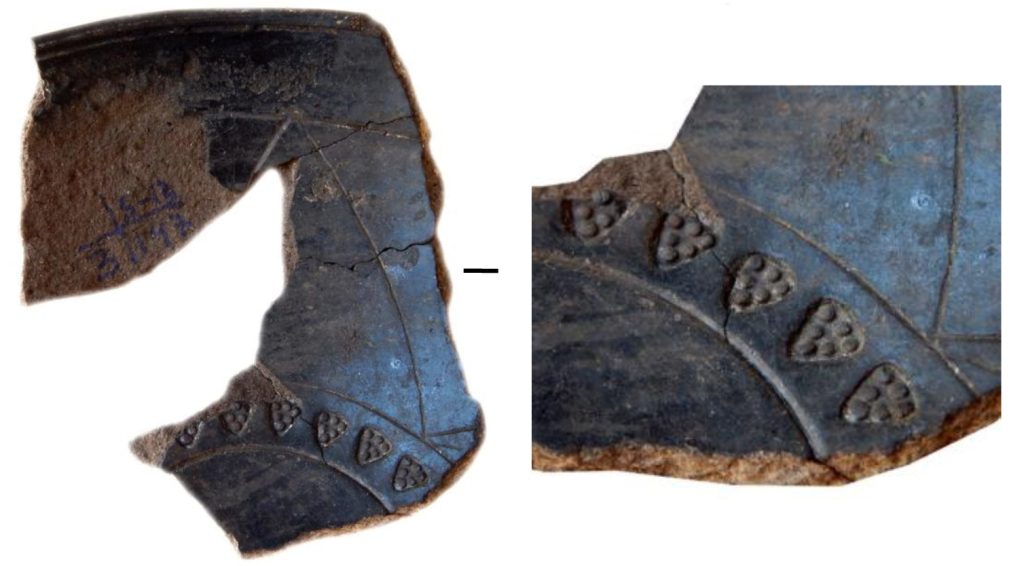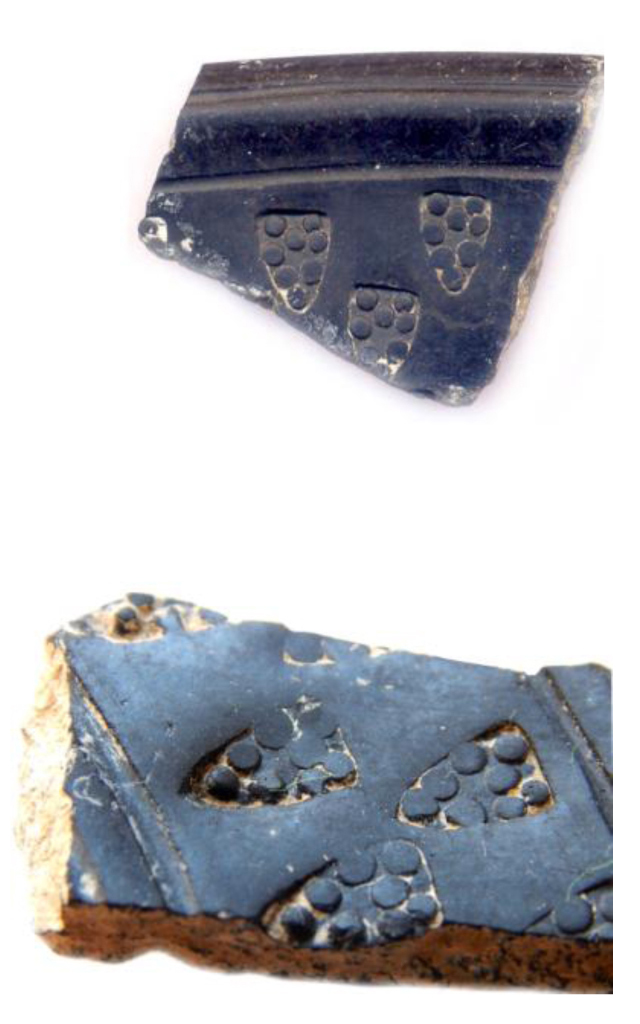The ceramics of the Classical period of Tigranakert (1st century BC-3rd century AD), represented by the richest collection of archaeological material discovered during a decade and a half of excavations, is important source for studying the material and spiritual culture of that period.
Besides rich diversity of shapes it has another important peculiarity: it is presented by luxurious painted pottery, black and gray ware, polished, and decorated by stamped and incised ornaments. Among this diversity there is a small but unique group of stamped vessels that can shed light on cultural innovations of Tigranakert, trade and cultural connections, and the cultural role it played in the region.
Exceptional examples of stamped pottery revealed from the excavations of Tigranakert carried out in different years are black polished, shining goblets, phialas, and fragments of bowls externally decorated with embossed grape clusters forming bands (fig.1). This ceramics is called “cluster-bearing vessels”, meaning that these decorations due to the conical, stamped designs with sharp bottoms and small circles inside are most probably representations of grape clusters.
An analysis of over thirty examples of cluster-bearing vessels reveal that the craftsmen of that period utilized at least nine stampers in order to create the conical clusters that contain from three to eleven grapes that are arranged in different ways (for example, in the case of six or eight circles).
However, despite the diverse samples noted above, there have been no pottery stampers discovered. It is possible to picture what they looked like based on their depiction at the famous sites of the Classical period in the West (fig.2). In order to be utilized comfortably, the stampers had long handles, which sometimes had one or two carved usable ends. The stamped designs were made while the clay was still in a moist, soft state.
Horizontal bands are seen 1.5-2 cm below the rim on the inner side of the black polished vessels of Tigranakert around the perimeter of the vessel and 1.5 cm apart, with the stamped clusters between them running horizontally and equidistantly all the way around. Sometimes two rows of cluster-bearing rows can be found in the same vessel.
During the excavations of the first urban quarter of Classical period carried out in 2013 a complete goblet was found, where the cluster-bearing row is located near the base of the vessel (fig.3). The belt, Almost 5 cm wide belt, formed between its concentric line 2.5 cm below the edge, is decorated with incised triangles.
Moreover, the ornament obtained by the symmetrical repeating pattern of one or more triangles embedded in the horizontal lines is one of the most widely used ornaments on painted pottery, was popular among the masters of Tigranakert. Sometimes two rows of cluster decorations can be found on the same vessel. In these cases, the first row is located very close to the rim of the vessel, like as on the phialas (Figure 1/3). The second cluster-bearing row is located near the base of the vessel, underlining the bottom. In some samples, the lip of the vessel is underlined with a gently carved stripe. There are also examples with the lip decorated with a grove line. Generally, the clusters are stamped into a straight band, but there are some vessels where the band near the lip is stamped in a staggered way in two lines (fig.4).
These cluster-bearing vessels were created in the unity of the shape, practical significance, and the ornament. According to the studies of the material, only the open vessels were stamped by grape cluster decorations and were intended for drinking liquid / wine. Goblets and phialas bearing cluster decorations confirm the proposition that winemaking was quite developed in Tigranakert of the Classical period. That is also approved by a rock-cut wine-press presented by a polygonal platform and a pit, discovered at the eastern foot of the fortified quarter of Tigranakert in 2012, as well as hundreds of fragments of wine vessels, painted amphorae, and goblets.
An elegant pendant made of blue glass in a shape of grape cluster found from the first urban quarter of the Classical period, as well as the archaeobotanical analyzes of carbonized grape seeds (Vitis vinifera) samples give an idea that at least two types of grapes were cultivated for technical and table purposes in Tigranakert of the Classical period.
The elegant performance of the whole composition of cluster-bearing vessels of Tigranakert, those black polished surface, which tends to leave the impression of varnishing, gives these vessels a special beauty, and provides ground to suppose that they were used for a special purpose.
Armine Gabrielyan
PHD, Institute of Archaeology and Ethnography National Academy of Sciences Republic of Armenia







 +374 44 60 22 22
+374 44 60 22 22
 Armenia Wine Company 3 Bild., 1Dead-end, 30 Street, Sasunik 0223
Armenia Wine Company 3 Bild., 1Dead-end, 30 Street, Sasunik 0223

